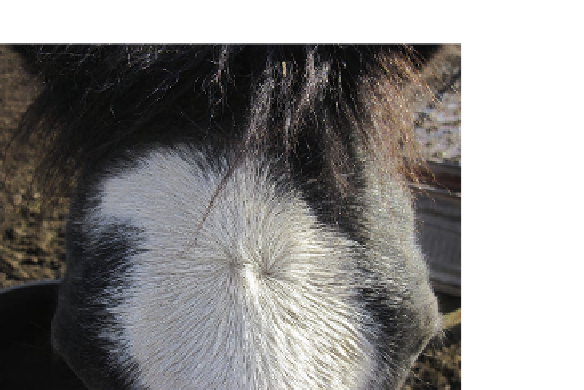Biology Reference
In-Depth Information
FIGURE 7.3
Double whorls. One whorl is usually higher.
The Heritability of Hair Whorls
Over the years, I noticed hair whorl position was heritable. For example: off-
spring of horses with high whorls almost always had a high whorl as well.
Breeding a low whorl to a high whorl, offspring usually had a hair whorl in
between the two but tending toward the high side. Inheritance of double
whorls was harder to pin down. I got lucky one day while shoeing a mare.
Her two offspring were standing at the fence, a yearling and a three-year-
old, both had double whorls. The mare had a high left side whorl. The owner
said the sire belonged to the neighbor down the road. When I finished with
the mare, I went down the road and asked to see the sire. His whorl was
high, like the mare's, but his was on the right side. Surprised by the simplic-
ity, I wondered if it was random. Determined to find out, it took nearly a
year to confirm my first observation. After that, I went out of my way to
look for other examples. Searching for examples was difficult, but over two
or three years I found several following the same pattern. I noticed in all
cases that whorls in the sire and dam were always high.
Many Traits are Conserved
After several years of observations and many discussions with owners about
their horses, I discovered something I never expected. One afternoon I was
shoeing a gelding with double whorls while talking to the owner about my
observations. I explained that breeding a left-sided whorl (a “lefty”) to a
right-sided whorl (a “righty”) is where the two whorls (ambidextrous) often
come from. He looked at me with an odd expression and said, “My mother
is right-handed, my father is left-handed, and I have two whorls on my head.
My son also has two whorls and we're both ambidextrous”. Frankly, I was




Search WWH ::

Custom Search